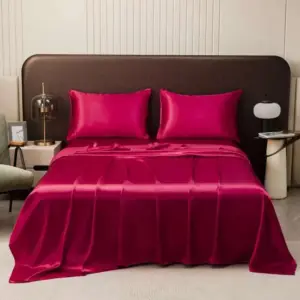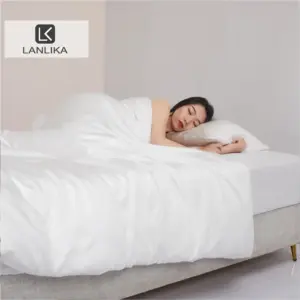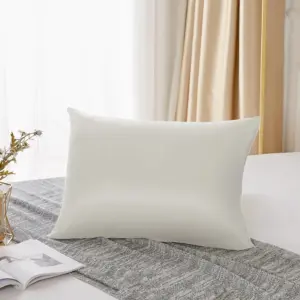Introduction
Have you ever woken up with creased skin, tangled hair, or feeling like you didn’t sleep well despite a full night’s rest? The culprit might be something you rarely consider – your pillowcase. We spend approximately one-third of our lives with our faces and hair pressed against pillowcases, making this seemingly simple bedding choice surprisingly significant for our overall well-being.
The material of your pillowcase does much more than provide a soft place to rest your head. It can:
- Impact hair breakage, frizz, and moisture retention
- Affect skin hydration, wrinkle formation, and acne development
- Influence temperature regulation and comfort during sleep
- Determine how long your pillowcase will last and how much care it requires
With so many options available, the choice between silk and cotton pillowcases stands out as particularly important. Each material offers distinct properties that can significantly benefit different hair types, skin conditions, and sleep preferences.
This comprehensive guide will help you navigate the silk versus cotton debate by examining the unique characteristics of each material, their specific benefits and drawbacks, and which might best suit your individual needs. By the time you finish reading, you’ll understand exactly which pillowcase material aligns with your priorities for amazing benefits Mulberry silk sheets provide and be ready to upgrade your sleep sanctuary with the perfect silk pillowcases for your needs.
What Makes a Quality Pillowcase?
Before diving into the specifics of silk versus cotton, it’s important to understand what constitutes a quality pillowcase regardless of material. Several key factors determine whether a pillowcase will provide comfort, durability, and benefits for your hair and skin.
Material Composition and Purity
The foundation of any quality pillowcase is its material composition. Pure, high-grade materials will always outperform blended or lower-quality versions. For cotton, this means looking for long-staple varieties like Egyptian or Pima. For silk, pure Mulberry silk represents the gold standard. Synthetic additives or lower-quality base materials can diminish the natural benefits of either option.
Construction Quality
Even the finest materials won’t perform well if poorly constructed. Quality pillowcases feature:
– Even, tight stitching that resists fraying
– French seams or other reinforced edge treatments
– Secure closures (envelope flaps, zippers, or buttons) that keep the pillow in place
– Properly aligned patterns and consistent sizing
Breathability and Temperature Regulation
A quality pillowcase should maintain comfort throughout the night by allowing air circulation while helping regulate temperature. This factor becomes especially important for those who sleep hot or experience night sweats.
Durability Considerations
Premium pillowcases represent an investment that should withstand regular use and washing. Quality indicators include color-fastness, resistance to pilling or thinning, and the ability to maintain shape and texture over time.
The reasons to choose Mulberry silk sheets often come down to these quality factors, which apply equally to pillowcases. Understanding these fundamental aspects helps establish a framework for comparing different materials based on objective criteria rather than just price or marketing claims.
Understanding Silk Pillowcases
Silk’s reputation as a luxury fabric dates back thousands of years, but its benefits extend far beyond mere opulence. To understand why silk pillowcases have gained such popularity, we must first understand what makes this material unique.
Origin and Production
Silk is a natural protein fiber produced by silkworms (Bombyx mori) as they create their cocoons. Mulberry silk—the highest quality and most common type used for bedding—comes from silkworms that feed exclusively on mulberry leaves. The production process involves carefully unwinding the filaments from the cocoon to create long, continuous strands that are then woven into fabric.
Quality Indicators
Not all silk is created equal, and the quality is primarily measured in momme weight (similar to thread count in cotton). This measurement indicates the density and durability of the silk:
– 16-19 momme: Entry-level, lighter weight
– 19-25 momme: Optimal balance of durability and softness for pillowcases
– 25+ momme: Premium, heavyweight silk
Physical Properties
Silk possesses several unique physical characteristics that set it apart:
– Exceptionally smooth surface with a low friction coefficient
– Natural protein structure containing amino acids similar to those found in human hair and skin
– Temperature-regulating properties that keep you cool in summer and warm in winter
– Natural hypoallergenic properties and resistance to dust mites, mold, and mildew
– Minimal absorbency that helps maintain skin and hair moisture levels
The lustrous appearance of silk comes from the triangular prism-like structure of the fiber, which refracts light at different angles. This structure also contributes to its smooth texture and ability to reduce friction against hair and skin.
The unique qualities that make Mulberry silk special go beyond luxury—they provide tangible benefits for both comfort and beauty. Our Mulberry silk pillowcases are carefully crafted to maximize these natural advantages while ensuring durability and ease of maintenance.
Understanding Cotton Pillowcases
Cotton stands as one of the world’s most widely used natural fibers, valued for its versatility, breathability, and durability. Understanding the properties of cotton helps explain why it has been a bedding staple for generations.
Origin and Production
Cotton is a plant-based fiber harvested from the seedpods of cotton plants. The fluffy fibers surrounding the seeds are collected, processed, and spun into threads that are then woven into fabric. Unlike silk’s continuous filaments, cotton consists of shorter staple fibers of varying lengths depending on the variety.
Types and Quality Variations
Cotton quality varies significantly based on the plant variety and processing methods:
– Egyptian cotton: Grown in Egypt’s Nile River Valley, known for extra-long staple fibers that produce exceptionally soft and durable fabric
– Pima/Supima cotton: American-grown long-staple cotton similar in quality to Egyptian
– Upland cotton: Most common variety, with shorter fibers and typically lower quality
– Organic cotton: Grown without synthetic pesticides or fertilizers
Thread Count and Weave
The quality of cotton is primarily measured by:
– Thread count: The number of threads per square inch, typically ranging from 200-800 for pillowcases
– Weave structure: Most commonly percale (crisp, cool) or sateen (smooth, warmer)
Higher thread counts generally indicate finer yarns and tighter weaves, though extremely high thread counts (above 600) may not necessarily mean better quality, as some manufacturers use creative counting methods.
Physical Properties
Cotton’s distinctive characteristics include:
– High absorbency, readily soaking up moisture from skin and hair
– Excellent breathability, allowing air circulation
– Natural fiber that becomes softer with repeated washing
– Durable and easy to care for under normal washing conditions
– Hypoallergenic properties, especially in organic varieties
Understanding these fundamental aspects of cotton provides context for the detailed quality comparison between cotton and silk, helping you make an informed decision based on your specific needs and preferences.
Silk vs. Cotton: A Comprehensive Comparison
To help you make the most informed decision, here’s a side-by-side comparison of silk and cotton pillowcases across key factors that affect your hair, skin, and sleep experience.
| Feature | Silk Pillowcases | Cotton Pillowcases |
|---|---|---|
| Texture | Smooth, cool, slippery surface | Soft but more textured surface |
| Friction | Very low friction (0.07-0.15 coefficient) | Moderate friction (0.25-0.30 coefficient) |
| Moisture Management | Low absorbency, maintains hair/skin moisture | High absorbency, wicks moisture away |
| Temperature Regulation | Naturally thermoregulating, adapts to body temperature | Breathable but less temperature-adaptive |
| Allergen Resistance | Naturally repels dust mites, mold, mildew | Can harbor allergens unless washed frequently |
| Care Requirements | Gentle hand wash or delicate cycle, air dry | Machine washable, tumble dry |
| Durability | 2-3 years with proper care | 3-5 years with standard care |
| Cost Range | $50-$150 for quality options | $15-$60 for quality options |
| Environmental Impact | Natural fiber, traditional production methods | Natural fiber, varies by farming practices |
Texture and Feel
The most immediately noticeable difference between silk and cotton is texture. Silk provides a smooth, cool-to-the-touch surface that glides against skin and hair. Cotton, while soft, has more texture and grip. This difference in surface friction is not just about comfort—it directly impacts how these materials interact with your hair and skin during hours of contact while sleeping.
Moisture Management
Silk’s low absorbency (approximately 11% of its weight) helps maintain your skin and hair’s natural moisture balance. Cotton, conversely, can absorb up to 27% of its weight in moisture, which draws hydration away from your skin and hair. This key difference explains why silk is often recommended for those with dry skin or hair concerns.
Temperature Regulation
Both materials offer good breathability, but they regulate temperature differently. Silk adapts to body temperature, providing a cooling effect in warm conditions and insulation when cold. Cotton excels at absorbing moisture and allowing heat to escape, making it feel cooler initially but potentially less comfortable if you perspire during sleep.
The detailed comparison between silk and cotton fabrics reveals that while both materials have strengths, their fundamental properties create very different interactions with your body during sleep.
Hair Benefits: How Each Material Affects Your Locks
The material you rest your head on each night can significantly impact your hair’s health, appearance, and manageability. Here’s how silk and cotton pillowcases differ in their effects on your locks.
Friction and Hair Damage
When you move during sleep, your hair rubs against your pillowcase. Cotton’s higher friction coefficient creates resistance that can:
– Rough up the hair cuticle, leading to frizz
– Catch and tangle hair strands
– Create breakage points, especially in fine or fragile hair
– Contribute to split ends over time
Silk’s smooth surface drastically reduces this friction. Hair glides across silk without catching or roughing up the cuticle, helping to:
– Maintain smoothness and shine
– Reduce morning tangles and bedhead
– Preserve hairstyles overnight
– Minimize breakage, particularly important for chemically treated or heat-styled hair
Moisture Retention
Cotton’s absorbent nature pulls moisture from your hair during the night. For those with dry or curly hair types that need to retain natural oils, this can exacerbate dryness issues. Silk’s low absorbency helps maintain your hair’s natural moisture balance, which is especially beneficial for:
– Curly and coily hair types that need moisture
– Color-treated hair that tends toward dryness
– Hair undergoing repair treatments
– Winter months when indoor heating creates dry conditions
Impact on Different Hair Types
The benefits of silk become particularly pronounced for certain hair types:
– Curly, coily, and textured hair: Reduced friction maintains curl definition and prevents disruption of curl patterns
– Fine or thinning hair: Less breakage means less apparent hair loss on pillowcases
– Long hair: Significant reduction in tangling and subsequent breakage during detangling
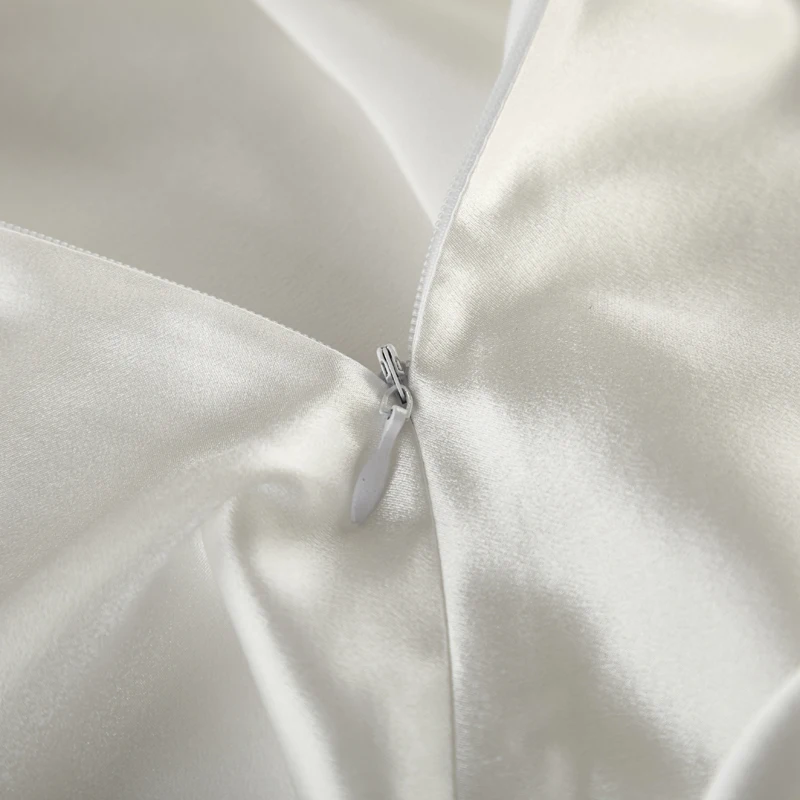
The specific comparison between silk and cotton for hair health shows measurable differences in friction damage, with many hairstylists recommending silk for clients concerned about hair preservation. Our standard size silk pillowcases provide these hair-protecting benefits while fitting most standard pillows.
Skin Benefits: The Pillowcase-Complexion Connection
The relationship between your pillowcase material and skin health extends far beyond comfort. During sleep, your facial skin remains in prolonged contact with your pillowcase, making this choice particularly important for skincare enthusiasts.
Sleep Creases and Wrinkles
One of silk’s most celebrated benefits is its potential to reduce sleep-induced wrinkles. When you sleep, your facial skin is pressed against your pillowcase, creating compression. On cotton pillowcases, the higher friction means your skin doesn’t glide as you move, resulting in:
– Temporary sleep creases that can become permanent over time
– Increased folding and compression of facial skin
– Potential acceleration of wrinkle formation, especially for side sleepers
Silk’s smooth surface allows your skin to glide without catching, significantly reducing these effects. Dermatologists note that while silk won’t reverse existing wrinkles, it can help prevent new ones from forming due to mechanical compression during sleep.
Moisture Retention
Similar to its effect on hair, cotton absorbs moisture from your skin throughout the night. This can:
– Disrupt your skin’s natural moisture barrier
– Lead to increased dryness, especially during winter months
– Potentially trigger increased oil production as compensation
– Affect the efficacy of applied nighttime skincare products
Silk preserves your skin’s natural moisture and allows night creams and serums to remain on your skin rather than being absorbed into your pillowcase.
Acne and Sensitive Skin Considerations
For those with acne-prone or sensitive skin, pillowcase choice becomes even more significant:
– Silk naturally repels dust mites, mold, and certain allergens
– Its smooth surface creates less irritation for inflammatory skin conditions
– The protein structure of silk contains amino acids that may be soothing to skin
– Less bacterial build-up occurs on silk (though regular washing remains important)
Research on Mulberry silk’s specific benefits for skin health suggests that those with sensitive skin conditions may find noticeable improvements when switching from cotton to silk pillowcases.
Sleep Quality and Comfort Factors
Beyond beauty benefits, your pillowcase material significantly impacts your overall sleep experience. The sensory aspects of different materials can influence how quickly you fall asleep and how restful your sleep feels.
Tactile Comfort
The immediate sensory experience differs dramatically between materials:
– Silk provides a cool, smooth surface that many describe as luxurious
– Cotton offers a familiar, soft comfort that feels secure and cozy
– Silk adapts quickly to body temperature, while cotton may feel cooler initially
These tactile differences can influence your psychological comfort as you’re falling asleep. Some sleepers find silk’s smooth texture helps them relax, while others prefer cotton’s more substantial feel.
Temperature Regulation
Sleep quality is closely tied to maintaining optimal body temperature. Materials play a crucial role in this regulation:
– Silk naturally adjusts to body temperature, helping prevent overheating
– The protein structure of silk makes it naturally cooling in summer and insulating in winter
– Cotton excels at absorbing moisture but may feel damp if you sweat during sleep
– Cotton’s breathability can help dissipate heat for hot sleepers
Movement and Noise
The physical properties of pillowcase materials affect more than just touch:
– Silk’s smooth surface allows your head to move easily as you change positions
– Cotton creates more friction, potentially disrupting light sleepers when moving
– Silk pillowcases tend to stay in place better on the pillow itself
– Cotton produces less noise with movement than some silk varieties
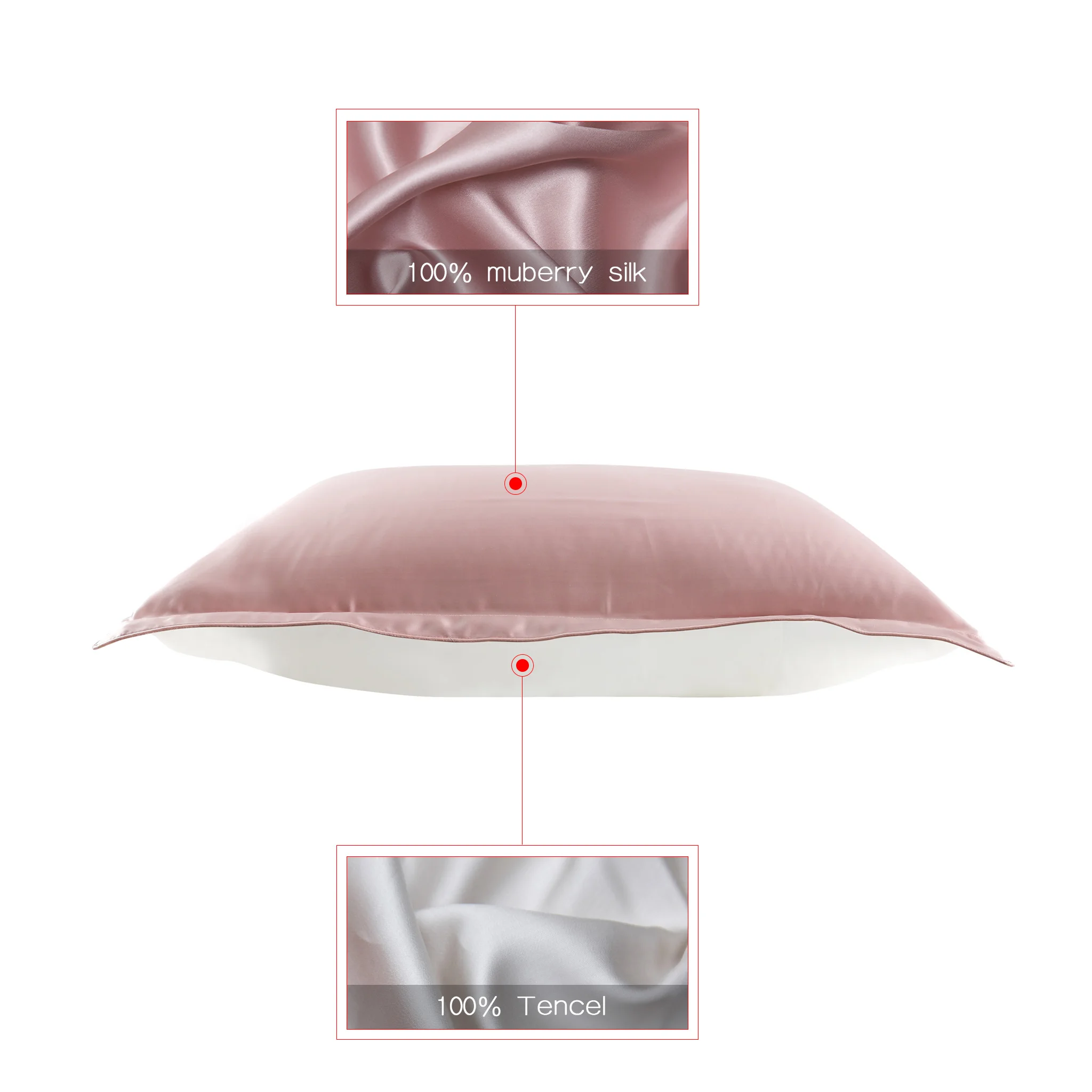
Learning how to transform your sleep quality with the right bedding can make a significant difference in your overall well-being. For those seeking a comprehensive sleep upgrade, our 100% silk sheets complement silk pillowcases perfectly for a consistent sleep surface experience.
Durability and Maintenance: The Practical Reality
While beauty and comfort benefits are important, the practical aspects of care and longevity should factor into your pillowcase decision. Understanding the maintenance requirements helps set realistic expectations for your investment.
Silk Pillowcase Care
Silk requires more careful handling than cotton:
– Washing: Hand wash with mild detergent or machine wash on delicate cycle in cold water
– Drying: Air dry away from direct sunlight; never tumble dry
– Ironing: If needed, use cool iron setting with a pressing cloth
– Detergents: Avoid enzymes, brighteners, and harsh chemicals
– Storage: Keep away from prolonged sunlight to prevent color fading
– Frequency: Wash every 1-2 weeks for optimal cleanliness
With proper care, quality silk pillowcases typically last 2-3 years before showing signs of wear.
Cotton Pillowcase Care
Cotton’s durability and easy maintenance make it practical for many households:
– Washing: Machine wash in warm water with regular detergents
– Drying: Tumble dry on medium heat
– Ironing: Easy to iron on medium to hot settings if desired
– Detergents: Compatible with most laundry products
– Storage: Minimal special requirements
– Frequency: Wash weekly for optimal hygiene
Quality cotton pillowcases generally last 3-5 years with regular care before thinning or showing significant wear.
Longevity Factors
Several factors affect how long either material will last:
– Quality of the original product (momme weight for silk, thread count for cotton)
– Frequency of washing and care methods used
– Exposure to facial oils, skincare products, and environmental factors
– Sleeping habits and movement during sleep
For those concerned about maintenance requirements, our washable silk sheets collection offers easier care options while maintaining silk’s benefits.
Full-size Silk Sheets, King Size Silk Sheets, Queen Size Silk Sheets, Twin Size Silk Sheets, Washable Silk Sheets
Price range: $95.95 through $178.37 Select options This product has multiple variants. The options may be chosen on the product page100% Silk Sheets, Green Silk Sheets, King Size Silk Bedding Set, Mulberry Silk Bedding Sets, Queen Size Silk Bedding Set
Price range: $1,246.21 through $1,615.22 Select options This product has multiple variants. The options may be chosen on the product pageGrey Silk Sheets, Silk Sheet and Pillowcase Set
Price range: $88.20 through $146.64 Select options This product has multiple variants. The options may be chosen on the product page100% Silk Sheets, King Size Silk Bedding Set, Mulberry Silk Bedding Sets, Queen Size Silk Bedding Set, White Silk Sheets
Price range: $1,000.79 through $1,351.42 Select options This product has multiple variants. The options may be chosen on the product pageKing Size Silk Pillowcases, Mulberry Silk Pillowcases, Queen Size Silk Pillowcases
Price range: $94.96 through $121.56 Select options This product has multiple variants. The options may be chosen on the product page100% Silk Sheets, Queen Size Silk Fitted Sheet, Queen Size Silk Pillowcases, Queen Size Silk Sheets
Price range: $259.05 through $284.13 Select options This product has multiple variants. The options may be chosen on the product page
Cost Analysis: Initial Investment vs. Long-term Value
The price difference between silk and cotton pillowcases represents one of the most significant factors in many purchasing decisions. Understanding what drives these differences helps determine whether the investment makes sense for your situation.
Price Range Comparison
- High-quality cotton pillowcases: $15-60 per pair
- Premium silk pillowcases: $50-150 per pair
This substantial difference reflects several factors:
– Raw material costs (silk production is more labor-intensive)
– Manufacturing complexity and skilled labor requirements
– Limited production volume compared to cotton
– Natural material properties and benefits
Value Considerations Beyond Price
When evaluating cost, consider these factors:
– Potential savings on hair products to combat frizz and damage
– Reduced need for anti-aging skincare products
– Extended life of hairstyles between washings
– Sleep quality improvements that affect overall well-being
Cost Per Use Analysis
Breaking down the investment over time reveals a different perspective:
– Premium silk pillowcase ($100) used for 2 years = approximately 14¢ per night
– Quality cotton pillowcase ($30) used for 3 years = approximately 3¢ per night
For many users, the 11¢ difference per night represents a worthwhile investment given the benefits. Others may find the initial cost barrier too high regardless of long-term value.
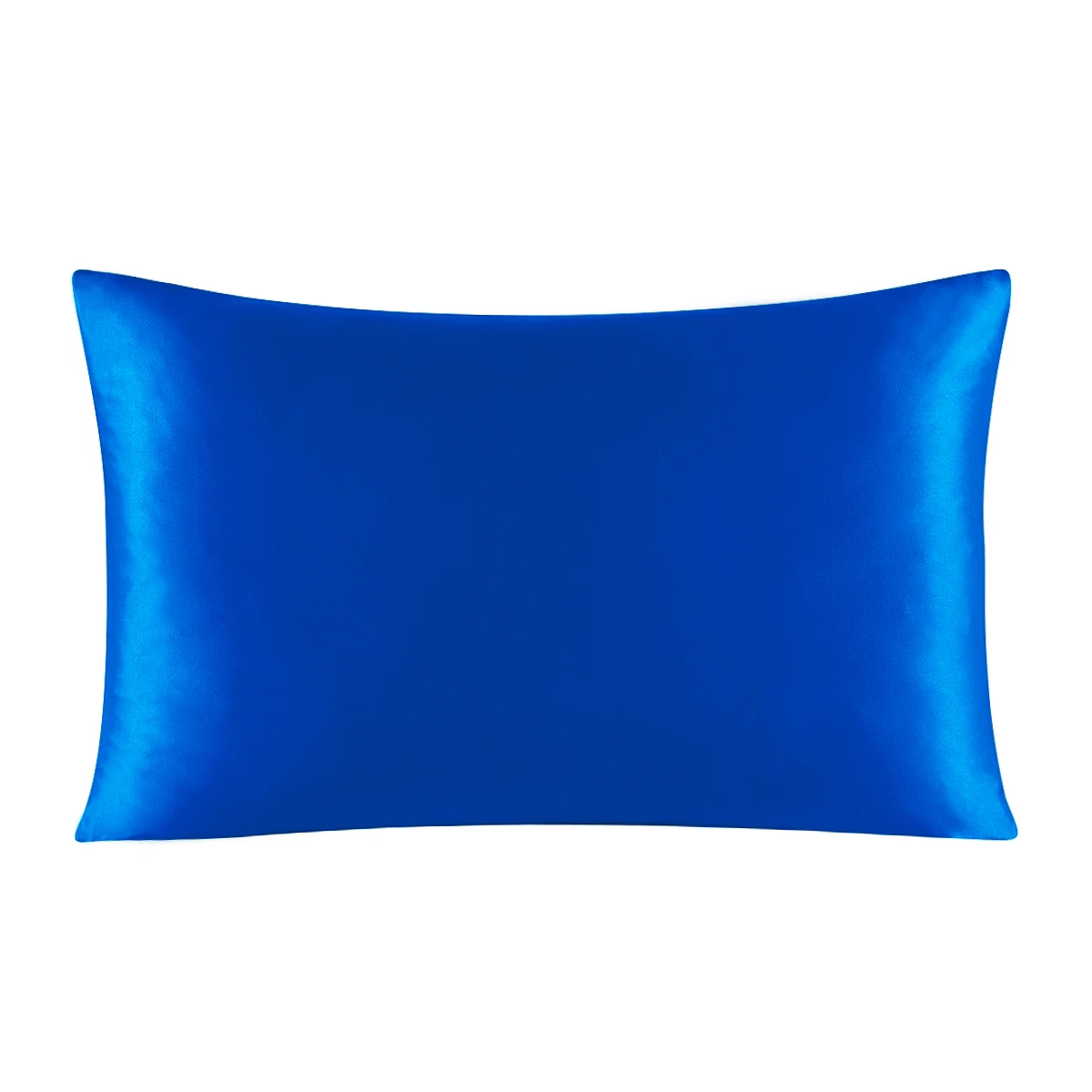
Understanding what determines quality through factors like silk pillowcase momme weight helps ensure you’re making a worthwhile investment rather than overpaying for lower-quality products.
Who Should Choose Silk Pillowcases?
While silk offers numerous benefits, it’s particularly well-suited for certain individuals. You might be an ideal candidate for silk pillowcases if you:
Have Specific Hair Concerns
- Experience significant frizz, especially in humid conditions
- Have curly, coily, or textured hair that tangles easily
- Deal with hair breakage or split ends
- Invest significantly in hair treatments or styling
- Have color-treated or chemically processed hair
- Style your hair before bed and want to preserve your look overnight
Focus on Skincare
- Are concerned about preventing facial wrinkles and sleep creases
- Use nighttime skincare products that you want to remain on your skin
- Have sensitive skin that reacts to rougher fabrics
- Experience facial redness or irritation
- Have mature skin that needs extra protection against friction
Have Particular Sleep Preferences
- Tend to sleep hot or experience night sweats
- Prefer a cool, smooth sleep surface
- Have sensory preferences for luxurious textures
- Are willing to follow special care instructions for bedding
Those with curly hair often see particularly dramatic benefits, as detailed in our guide to silk pillowcases for curly hair care.
Who Should Choose Cotton Pillowcases?
Cotton pillowcases remain the most popular choice worldwide for good reasons. You might prefer cotton if you:
Have Practical Considerations
- Prioritize easy care and maintenance
- Prefer machine washing and drying without special precautions
- Work within a tighter household budget
- Value longevity and durability in household items
- Prefer crisp, cool-feeling bedding
Have Specific Skin Types
- Have oily skin that benefits from cotton’s absorption properties
- Don’t typically use heavy nighttime moisturizers
- Haven’t noticed skin irritation from standard bedding materials
- Prefer the feeling of a more textured fabric against your skin
Have Particular Sleep Preferences
- Enjoy the familiar feel of traditional bedding
- Prefer a more substantial fabric weight
- Like the cooling effect of cotton’s moisture-wicking properties
- Want the widest range of color and pattern options
Many households choose a combination approach, using our silk sheet and pillowcase sets for primary bedrooms while maintaining cotton options for guest rooms or seasonal rotation.
How to Select the Best Silk Pillowcase
If you’ve decided silk is right for you, follow these guidelines to ensure you select a quality product that delivers the benefits you’re seeking:
Key Quality Indicators
- Momme Weight: Look for 19-25 momme for the best balance of durability and softness
- Silk Type: Choose 100% Mulberry silk for highest quality
- Closure Type: Hidden zippers provide secure pillow containment
- Seam Construction: French seams or similar reinforced construction prevent fraying
- Certifications: OEKO-TEX certification ensures the product is free from harmful substances
Size and Fit Considerations
- Standard size (20”×26”) fits most common pillows
- Queen size (20”×30”) provides extra length
- King size (20”×36”) matches larger pillows
- Always check your existing pillow measurements before purchasing
Color Selection Tips
- Darker colors may show less staining from skincare products
- Natural, undyed silk offers the most hypoallergenic properties
- Color-fast dyes prevent bleeding onto other bedding
The question of whether silk pillowcases truly help hair is answered by both scientific measurements of friction reduction and countless user testimonials about reduced breakage and frizz.
How to Select the Best Cotton Pillowcase
If cotton aligns better with your needs, these guidelines will help you select quality options that maximize cotton’s natural benefits:
Quality Indicators for Cotton
- Thread Count: Look for 300-600 thread count (higher isn’t always better)
- Cotton Type: Long-staple varieties like Egyptian or Pima provide superior softness
- Weave Type: Percale offers crisp coolness; sateen provides smoother texture
- Organic Certification: GOTS certification ensures organic growing practices
- Construction: Double-stitched seams indicate attention to durability
Weave Considerations
- Percale weave (one-over, one-under) creates a matte, crisp feel ideal for hot sleepers
- Sateen weave (three-over, one-under) creates a smoother surface closer to silk’s feel
- Twill weave offers durability but less softness
Pre-Purchase Evaluation
- Feel the fabric if possible before purchasing
- Check for even stitching and consistent color
- Consider pre-washed options that have already undergone initial shrinkage
- Read user reviews focusing on softness after multiple washes
For those who appreciate both materials, our luxury silk bedding sets can be complemented with high-quality cotton items for versatile bedding options.
FAQ: Your Top Questions About Pillowcase Materials
Is the difference between silk and cotton pillowcases really noticeable?
Yes, the difference is immediately noticeable in texture and becomes apparent in hair and skin effects within 1-2 weeks of consistent use. Most users report less morning frizz and fewer sleep creases within days of switching to silk.
How often should I replace my pillowcase?
Cotton pillowcases typically last 3-5 years before showing significant wear. Silk pillowcases generally last 2-3 years with proper care. However, for hygiene reasons, washing pillowcases weekly is recommended regardless of material.
Can silk pillowcases help with acne?
While not a cure for acne, silk pillowcases may help by: 1) not absorbing applied acne treatments, 2) reducing bacterial buildup compared to cotton, and 3) creating less friction that could irritate existing blemishes. Results vary by individual.
Are there any allergen considerations with either material?
Both silk and cotton can be hypoallergenic, but silk naturally repels dust mites, mold, and mildew, making it potentially better for allergy sufferers. Organic cotton minimizes exposure to pesticides and chemical processing agents.
Do silk pillowcases really prevent hair breakage?
Studies show silk reduces friction against hair by up to 43% compared to cotton, which directly correlates to reduced breakage. This is particularly noticeable for those with fine, fragile, or curly hair types. Learn more about how silk pillowcases reduce hair breakage.
Are satin pillowcases as good as silk ones?
No. While satin pillowcases mimic silk’s smooth texture, they lack the protein structure and natural properties of silk. Satin (typically polyester) doesn’t offer the same temperature regulation, may create static, and doesn’t provide the same amino acid benefits for hair and skin.
How can I tell if a silk pillowcase is authentic?
Authentic silk has a distinctive shimmery appearance, feels cool to the touch initially, and makes a subtle rustling sound when scrunched. The burn test (small thread sample burns to ash rather than melting) can confirm natural silk versus synthetic alternatives.
Does thread count really matter for cotton pillowcases?
Yes, but with limitations. Thread count between 300-600 generally indicates quality cotton, but extremely high thread counts can be misleading marketing tactics. The type of cotton (long-staple) and weave quality matter more than extremely high numbers.
Final Verdict: Making Your Choice
The decision between silk and cotton pillowcases ultimately comes down to your personal priorities and specific needs. Both materials offer distinct advantages that make them suitable for different situations.
Silk stands out for its exceptional benefits for hair and skin, offering reduced friction, moisture retention, and potential long-term beauty benefits. Its luxurious feel and temperature-regulating properties provide a premium sleep experience, albeit at a higher price point and with more demanding care requirements.
Cotton offers practical advantages in durability, ease of care, and affordability. Its comfortable familiarity and excellent breathability make it a reliable choice for many households, particularly those with budget constraints or preferences for crisp, cool bedding.
Rather than viewing this as a simple “better or worse” comparison, consider your individual:
– Hair type and concerns
– Skin conditions and sensitivities
– Sleep temperature preferences
– Maintenance willingness
– Budget constraints
The right choice is the one that addresses your primary concerns while fitting comfortably within your lifestyle and budget. For many, the investment in silk pays dividends in reduced hair damage and potential skincare benefits. For others, high-quality cotton offers the best balance of performance and practicality.
Understanding how different pillowcase materials affect healthy hair and skin helps you make this decision based on your unique priorities rather than general recommendations.
At Sanctuary Soft, we believe that choosing bedding that enhances your wellbeing is a personal journey. Whether you select silk or cotton, investing in quality materials for your sleep environment represents an investment in your daily comfort and long-term health.


